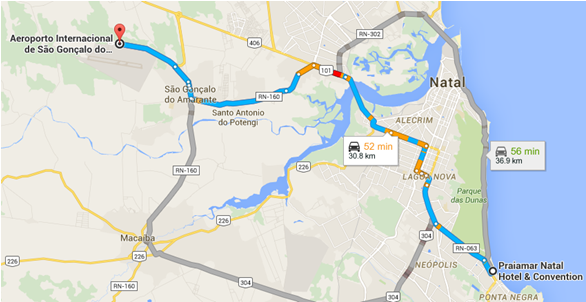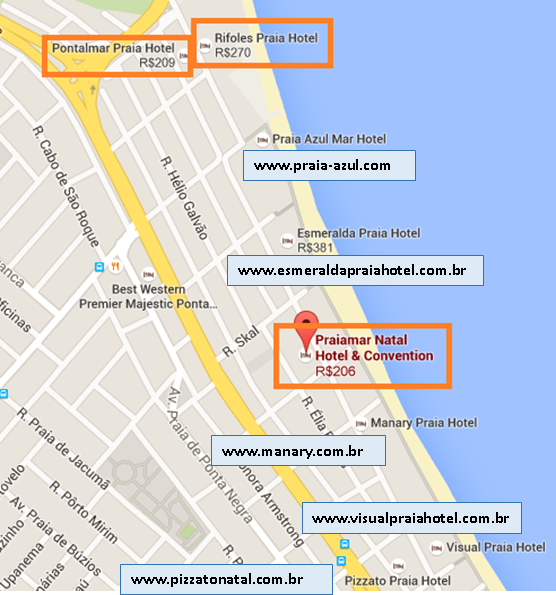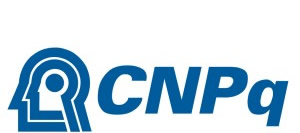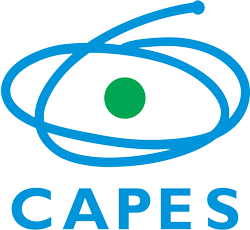Natal has an international airport with connections to most Brazilian state capitals and to Lisbon and Milan (through Fortaleza)
The following companies fly to Natal:
AVIANCA www.avianca.com.br
AZUL www.voeazul.com.br
MERIDIANA www.meridiana.it
TAM www.tam.com.br
TAP www.flytap.com
The airport is approximately 31km from the conference hotels, as indicated in the following map. The journey takes around fifty minutes by car, depending on the traffic. There taxi and van services available at the airport. A special van service has been hired by SBF. All those willing to use it please send a message to Beatriz Mattos – Este endereço de email está sendo protegido de spambots. Você precisa do JavaScript ativado para vê-lo., specifying the date, time of arrival, and number of persons. This service will cost R$ 30,00/person.
Due to budget restrictions, SBF is asking all invited speakers for the plenary and symposia sections to pay their own air tickets. However, the foreign invited speakers that do not have available funds can have their tickets acquired by SBF or be reimbursed on the basis of economy class. Those needing this help and who have not yet done it, are kindly requested to send a message to Beatriz Mattos – Este endereço de email está sendo protegido de spambots. Você precisa do JavaScript ativado para vê-lo. specifying their flight plan.
In the case of invited speakers from Brazil, the payment of air transportation will depend on the approval of the funding applications submitted by SBF to different agencies.

(Areas associated with the National Meeting on Condensed Matter)
1.01 ATOMIC AND MOLECULAR PHYSICS
1.01.1 Electronic Structure and Dynamics of Atoms, Molecules and Clusters
1.01.2 Large Molecular Systems: Clusters, Proteins, Enzymes, Quantum Dots, DNA fragments, and Others
1.01.3 Exotic Atoms and Molecules
1.01.4 Atomic and Molecular Collisions
1.01.5 Photophysics and Spectroscopy of Atomic and Molecular Systems
1.01.6 Cold Atoms and Bose-Einstein Condensates
1.01.7 Solvation Effects
1.02 OPTICS AND PHOTONICS
1.02.1 Quantum Optics
1.02.2 Optics and Atomic Physics
1.02.3 Optics and Biosciences
1.02.4 Optical Materials and Nonlinear Optics
1.02.5 Lasers and Photonics
1.02.6 Nanophotonics, Nanooptics and Plasmonics
1.02.7 Biophotonics and applications
1.03 QUANTUM INFORMATION
1.03.1 Quantum Cryptography, Quantum Communication, and Quantum Measurement
1.03.2 Quantum Entanglement
1.03.3 Quantum Computing, Quantum Algorithms, and Quantum Simulation
1.03.4 Quantum Error Correction and Quantum Control
1.03.5 Open Quantum Systems and Decoherence
1.03.6 Physical Implementations of Qubits
1.03.7 Foundations of Quantum Theory and Quantum Thermodynamics
1.04 SOFT MATTER
1.04.1 Polymers: Structure and Dynamics
1.04.2 Polymers: Electronic and Optical Properties
1.04.3 Liquid Crystals and Complex Fluids
1.04.4 Organic Electronics and Photonics
1.04.5 Biological Fluids, Micellar Structures and Membranes
1.05 BIOLOGICAL PHYSICS
1.05.1 Physics of Biological Macromolecules: Dynamics, Function and Interactions
1.05.2 Physics of Membranes: Biological and Synthetic
1.05.3 Biological Networks
1.05.4 Biomechanics
1.05.5 Physics of Multi-cellular Processes
1.05.6 Dynamics of Biological Systems
1.05.7 Biological Materials: Synthesis, Characterization and Applications
1.05.8 Instrumentation for Biological Physics
1.05.9 New Methods in Biological Physics
1.06 MEDICAL PHYSICS
1.06.1 Radiation Therapy
1.06.2 Radiodiagnostics
1.06.3 Imaging Physics
1.06.4 Radiation Dosimetry
1.06.5 Nuclear Medicine
1.06.6 Optical Physics in Medicine
1.06.7 Radiation Biology
1.06.8 Radiological Protection
1.06.9 Instrumentation for Medical Physics
1.07 INSULATORS AND DIELECTRICS
1.07.1 Growth, Structure, Properties and Defects
1.07.2 Oxides
1.07.3 Minerals and Geological Materials
1.07.4 Topological Insulators
1.07.5 Dielectrics
1.08 METALS AND METALLIC ALLOYS
1.08.1 Structural, Mechanical and Thermodynamic Properties
1.08.2 Electronic, Transport and Optical Properties
1.09 NON-CRYSTALLINE SYSTEMS
1.09.1 Glasses and Amorphous Materials
1.09.2 Quasicrystals
1.09.3 Natural Materials
1.09.4 Biomaterials
1.10 MAGNETISM
1.10.1 Dynamical Magnetization
1.10.2 Spintronics
1.10.3 Nano and Molecular Magnetism
1.10.4 Magnetism in Thin Films and Surfaces
1.10.5 Theory and Simulation in Magnetism
1.10.6 Magnetic Semiconductors
1.10.7 Magnetic Oxides
1.10.8 Magnetic Devices and Applications
1.10.9 Magnetocaloric Effect
1.11 NANOMATERIALS
1.11.1 Graphene: Monolayer and Multilayer
1.11.2 2D Materials Beyond Graphene and Van der Waals Heterostructures
1.11.3 Nanotubes
1.11.4 Nanowires
1.11.5 Nanoparticles
1.11.6 Quantum Dots
1.12 SEMICONDUCTORS
1.12.1 Quantum Wells, Quantum Wires and Quantum Dots
1.12.2 Spin-Dependent Phenomena
1.12.3 Bulk and Alloy Semiconductors
1.12.4 Defects and Doping
1.12.5 Superlattices and Heterostructures
1.12.6 Semiconductor Growth and Surfaces
1.12.7 Transport Properties
1.12.8 Optical Properties
1.12.9 Devices and Applications
1.12.10Quantum Hall Effect
1.13 STRONGLY CORRELATED SYSTEMS
1.13.1 Metal-Insulator and Other Correlated Phase Transitions
1.13.2 Heavy Fermions
1.13.3 Non-Fermi Liquids
1.13.4 Complex Oxides
1.13.5 Correlated Electron Magnetism
1.13.6 Quantum Fluids and Quantum Solids
1.14 SUPERCONDUCTIVITY
1.14.1 Materials: Growth, Structure and Characterization
1.14.2 Theory, Models and Mechanisms of Superconductivity
1.14.3 Novel Superconductors: Fe-Based, MgB2, Organic, etc.
1.14.4 Dynamics and Pinning of Vortex Matter
1.14.5 Superconductivity at the Meso and Nanoscales
1.14.6 Superconducting Devices and Applications
1.15 SURFACES, INTERFACES AND THIN FILMS
1.15.1 Growth, Structure and Morphology
1.15.2 Surface Reactions and Catalysis
1.15.3 Electronic and Lattice Properties
1.15.4 Applied Surface Science
1.16 THEORY AND SIMULATION
1.16.1 Electronic Structure Methods
1.16.2 Classical Monte-Carlo and Molecular Dynamics
1.16.3 Quantum Many-Body Systems and Methods
1.16.4 Fluid and Polymer Simulations
1.17 APPLICATIONS AND DEVICES
1.17.1 Energy Storage and Conversion
1.17.2 Photovoltaics
1.17.3 Thermoelectrics
1.17.4 Biofuels
1.17.5 Solid-State Lighting
1.17.6 Printed Electronics
1.17.7 Electroacoustics and Piezoelectric Applications and Devices
1.17.8 Applications of Composite and Hybrid Materials
1.18 INSTRUMENTATION
1.18.1 Detectors, Sensors, & Transducers
1.18.2 Spectroscopic Techniques
1.18.3 Scattering & Diffraction
1.18.4 Microscopic and Scanning Probe Techniques
1.18.5 Signal Processing & Analysis
1.18.6 Thermal & IR Instrumentation
1.18.7 Other Instrumentation and Measurement Science
1.19 STATISTICAL PHYSICS
1.19.1 Complex systems
1.19.2 Critical phenomena and phase transitions
1.19.3 Disordered and glassy systems
1.19.4 Growth phenomena
1.19.5 Long-range interactions
1.19.6 Population dynamics
1.19.7 Thermodynamics and thermostatistics
1.19.8 Transport, flows and diffusion
1.19.9 Nonlinear dynamics
(Areas associated with the Workshop on Nuclear Physics in Brazil)
2.AI Applications and Instrumentation
2.ER Structure and Reactions
2.HF Hadrons and Fundamental Interactions
(Areas associated with the National Meeting on Particles and Fields)
3.CGR Cosmology and Gravitation
3.FEX High Energy Experimental Physics
3.FPE Phenomenology of Elementary Particles
3.TQC Field Theory
(Areas associated with National Meeting on Plasma Physics)
4.ATP Technological Applications of Plasmas
4.FBP Basic Phenomena in Plasmas
4.FTC Controlled Thermonuclear Fusion
4.PEA Space and Astrophysical Plasmas
(Areas associated with National Meeting on Research in Physics Teaching)
5.01 Teaching/Learning/Evaluation in Physics
5.02 Training and Professional Practice of the Physics Teacher
5.03 Philosophy, History, and Science Sociology and Physics Teaching
5.04 Physics and Communication in formal, informal and non-formal educative practices
5.05 Information and Communication Technology and Physics Teaching
5.06 Teaching, Curriculum, and Educational Innovation in Physics Teaching
5.07 Language and Cognition in Physics Teaching
5.08 Sciences, Technology, Society, and Environment and Physics Teaching
5.09 Public Policies in Education and Physics Teaching
5.10 Theoretical-Methodological Questions and new demands in Research in Physics Teaching
As mentioned in the Program, the morning activities will be held in the three conference hotels according to the following distribution
ATT: Booking at Praimar Hotel, Rifoles Hotel and PontalMar Hotel should be done directly with the hotel for "Encontro de Física 2016".
Praiamar Hotel - Condensed Matter and Physics Teaching
Este endereço de email está sendo protegido de spambots. Você precisa do JavaScript ativado para vê-lo.
Rifoles Praia Hotel – Particles and Fields
Este endereço de email está sendo protegido de spambots. Você precisa do JavaScript ativado para vê-lo.
Pontalmar Praia Hotel – Plasma and Nuclear Physics
Este endereço de email está sendo protegido de spambots. Você precisa do JavaScript ativado para vê-lo.
Therefore, those who wish to stay close to their fellows of the same area are suggested to book at the corresponding hotel. Nevertheless, the hotels are rather close to each other and there will be a free shuttle service among them.
Besides these hotels, are many others, including lower prices pensions, bed&breakfast available at Ponta Negra coast, as indicated in the following map.
All participants but the plenary invited speakers are required to make their own booking. Foreign invited speakers that need help with booking can contact Beatriz Mattos – Este endereço de email está sendo protegido de spambots. Você precisa do JavaScript ativado para vê-lo..
The basic hotel expenses (room and breakfast) of all foreign invited speakers will be covered by SBF. Brazilian invited speakers might have partial coverage of their hotel expenses depending on approval by funding agencies.

Simultaneous to the scientific sessions, we will hold EXPO-FÍSICA, an opportunity for your company to demonstrate its latest products and services to the Physical sciences community in Brazil. Our audience will include professionals with decision-making power or strong influence on purchasing products and services. EXPO-FÍSICA also represents an opportunity to establish contacts with researchers from all over the country.
The exhibition room will be strategically located, with direct access from the meeting rooms, and all the coffee-breaks and poster sessions will also be co-located with the exhibition – all with the goal of maximizing circulation in the exhibition area.
Finally, this year will have a session dedicated to the presentation of new products and technologies. The goal is to expose the community to more in-depth descriptions of novel techniques that may have been recently implemented in your product . If your company desires to participate, please submit an abstract with your application. The planning committee will review all submissions. We note that although this session is not necessarily scientific in nature, an in-depth technical presentation is required.


